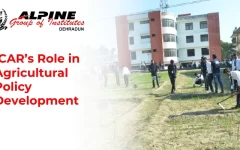Innovations in Crop and Livestock Production: Shaping the Future of Farming
2024-12-16 9:40Innovations in Crop and Livestock Production: Shaping the Future of Farming
Agriculture has always been at the heart of human civilization, providing the food, fiber, and resources necessary for survival. But as the global population grows, so does the need for more efficient, sustainable farming practices. Fortunately, innovations in crop and livestock production are helping farmers tackle the challenges of feeding the world while protecting the environment. From groundbreaking technologies that boost crop yields to the promise of gene editing, agriculture is entering a new era.
Agriculture is evolving at an unprecedented pace, driven by technological breakthroughs, scientific advancements, and growing global challenges. Farmers are under increasing pressure to produce more food, while facing constraints such as climate change, resource limitations, and shifting consumer demands. Fortunately, innovations in crop and livestock production are offering new tools, strategies, and solutions that are transforming farming practices and shaping the future of food production.
5 Breakthrough Technologies Improving Crop Yields
Increasing crop yields is a critical goal in agriculture, especially as the global population continues to rise. To meet the demand for food, farmers are turning to new technologies that make farming more efficient, sustainable, and productive. Here are five breakthrough technologies helping to improve crop yields:
1. Precision Agriculture: Data-Driven Farming for Greater Efficiency
One of the most significant innovations in modern agriculture is precision farming. This approach uses data, technology, and advanced tools to make farming practices more efficient, sustainable, and productive. Farmers are now able to manage every aspect of their farm with pinpoint accuracy, from water usage to fertilization and pest control.
How it works:
GPS-guided Tractors
Modern tractors equipped with GPS systems allow farmers to apply seeds, fertilizers, and pesticides with extreme precision. This reduces waste, ensures optimal crop growth, and minimizes environmental impact.
Drones and Sensors
Drones equipped with multispectral sensors can monitor crop health from above, allowing farmers to quickly detect issues like nutrient deficiencies, disease, or pest infestations. This early detection allows for more targeted interventions.
Data Analytics
With the help of big data and cloud computing, farmers can analyze soil moisture, temperature, weather forecasts, and crop performance to make informed decisions that boost yields and reduce costs.
Benefits
Increased Yields:
By optimizing resource use, precision farming can significantly increase crop yields.
Cost Efficiency:
Farmers can save on inputs like water, fertilizer, and pesticides, reducing costs while improving profitability.
Sustainability:
Precision farming promotes more sustainable practices by minimizing overuse of chemicals and conserving water, which is crucial in an era of climate uncertainty.
2. Vertical Farming: Growing More with Less Space
As urban populations grow, the demand for local, fresh food is rising. Traditional farming methods can be inefficient in urban settings due to space limitations, long transportation distances, and high land costs. Enter vertical farming, an innovative farming method that allows crops to be grown indoors, stacked in layers, often in repurposed buildings or shipping containers.
How it works:
Vertical farms use hydroponics or aeroponics ,which are soil-free growing systems to grow plants in nutrient-rich water or air. LED lighting provides the light necessary for photosynthesis, allowing crops to grow in controlled environments year-round.
Benefits:
Space Efficiency:
Vertical farming can be done in small spaces, even in city buildings, offering a solution to urban food shortages.
Water Conservation:
These systems use up to 90% less water than traditional farming, which is critical in water-scarce regions.
Year-Round Production:
Vertical farms can operate 365 days a year, independent of seasonal weather changes, ensuring a consistent supply of fresh produce.
While vertical farming is still developing, it holds significant promise for producing fresh food in urban areas, reducing food miles, and improving food security.
3. CRISPR Gene Editing: Revolutionizing Crop and Livestock Breeding
One of the most groundbreaking advancements in agriculture is CRISPR gene editing. This powerful technology allows scientists to make precise edits to the DNA of plants and animals, unlocking the potential for more resilient, nutritious, and sustainable crops and livestock.
How it works:
CRISPR uses a naturally occurring enzyme to “cut” DNA at specific locations, allowing scientists to remove, add, or alter genes with remarkable precision. Unlike traditional genetic modification, which often introduces foreign genes into an organism, CRISPR can edit the organism’s existing genes, making the changes more targeted and natural.
Applications in crops:
Disease Resistance:
CRISPR is being used to create crops that are resistant to diseases like wheat rust, which can decimate entire harvests.
Drought Tolerance:
Gene editing can make crops more resilient to extreme weather conditions, such as droughts, ensuring that they can grow in areas with limited water resources.
Improved Nutrition:
CRISPR can be used to enhance the nutritional profile of crops, such as increasing the levels of vitamins and minerals in staple crops like rice and corn.
Applications in livestock:
Disease Resistance:
CRISPR is also being used to develop livestock that are resistant to diseases like African Swine Fever, which has devastated pig populations in some regions.
Improved Productivity:
By editing genes, CRISPR can help animals grow faster, be more disease-resistant, and have improved feed conversion ratios.
Animal Welfare:
CRISPR can be used to reduce harmful traits in animals, such as the genetic mutations that cause certain livestock diseases or welfare issues.
Benefits:
Faster Results:
CRISPR can achieve desired traits much more quickly than traditional breeding methods, reducing the time and resources required to develop new crop varieties or livestock breeds.
More Sustainable Food Production:
By creating crops and animals that require fewer resources and are more resistant to pests and diseases, CRISPR has the potential to reduce the environmental impact of farming.
4. Biotech Crops: Enhancing Food Security Through Genetic Modification
Biotechnology has been instrumental in improving crop yields and food security. Biotech crops (or genetically modified crops) are engineered to have specific beneficial traits, such as resistance to pests, tolerance to herbicides, or improved nutritional content.
Benefits:
Increased Yields:
Biotech crops are more resistant to pests, diseases, and environmental stressors, leading to higher yields and less crop loss.
Reduced Environmental Impact:
Biotech crops can reduce the need for chemical inputs (like pesticides and herbicides), benefiting the environment and reducing costs for farmers.
Improved Food Security:
By developing crops that are more resilient to environmental challenges, biotech crops can help ensure a stable food supply, particularly in regions with challenging growing conditions.
Conclusion: The Future of Farming is Innovation
Innovations in crop and livestock production are not just reshaping the way food is grown, but they are also offering solutions to some of the most pressing challenges in agriculture today. From precision farming and CRISPR gene editing to vertical farming and biotech crops, these technologies are helping farmers produce more food with fewer resources, while also reducing environmental impact and improving sustainability.
As the global population grows and the planet faces increasing challenges related to climate change and resource scarcity, the agricultural industry must continue to innovate. By embracing new technologies and practices, farmers can ensure that they remain resilient and capable of meeting the world’s growing food demands, now and in the future. The future of farming is bright, and it’s being shaped by innovation.









